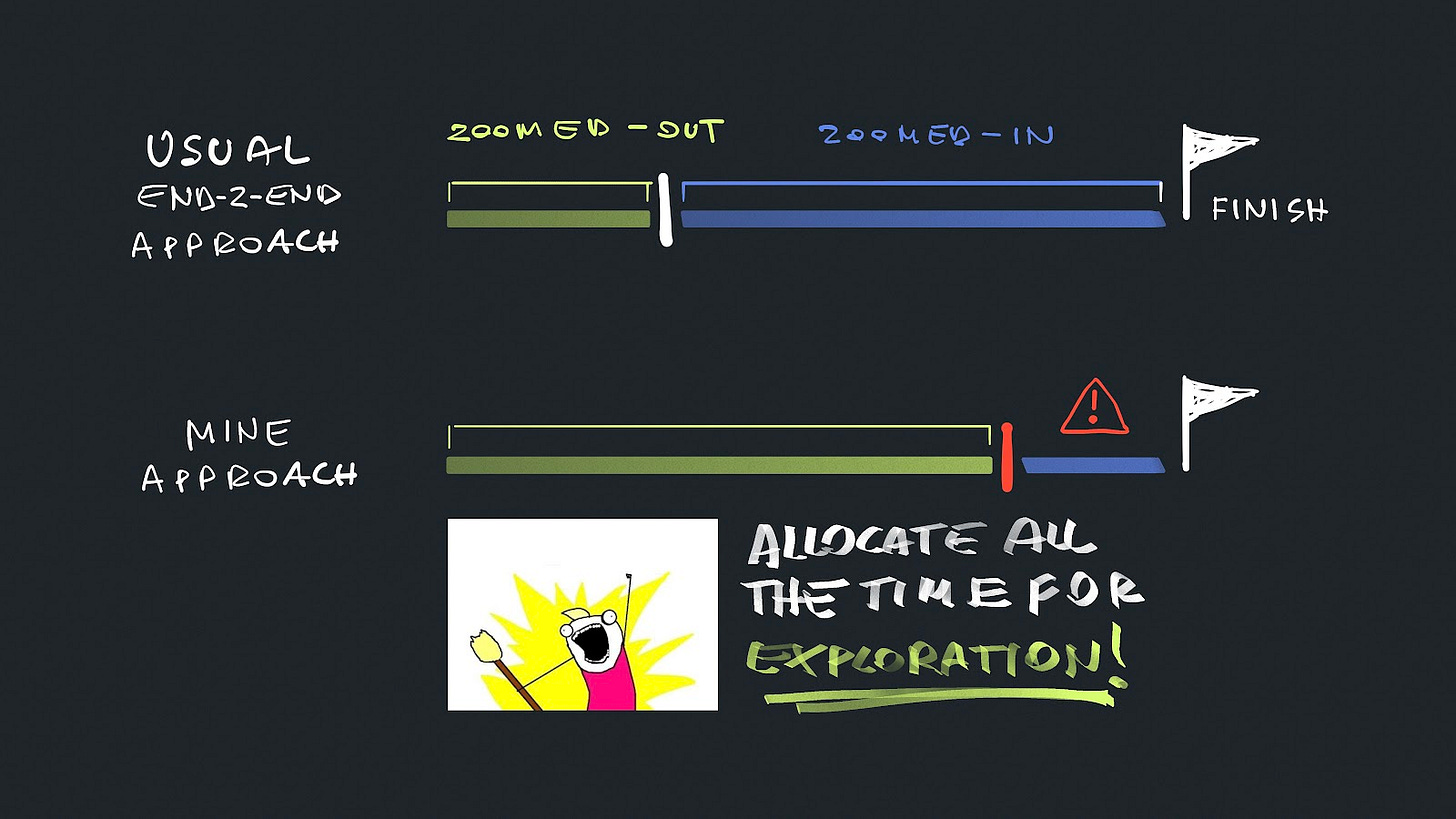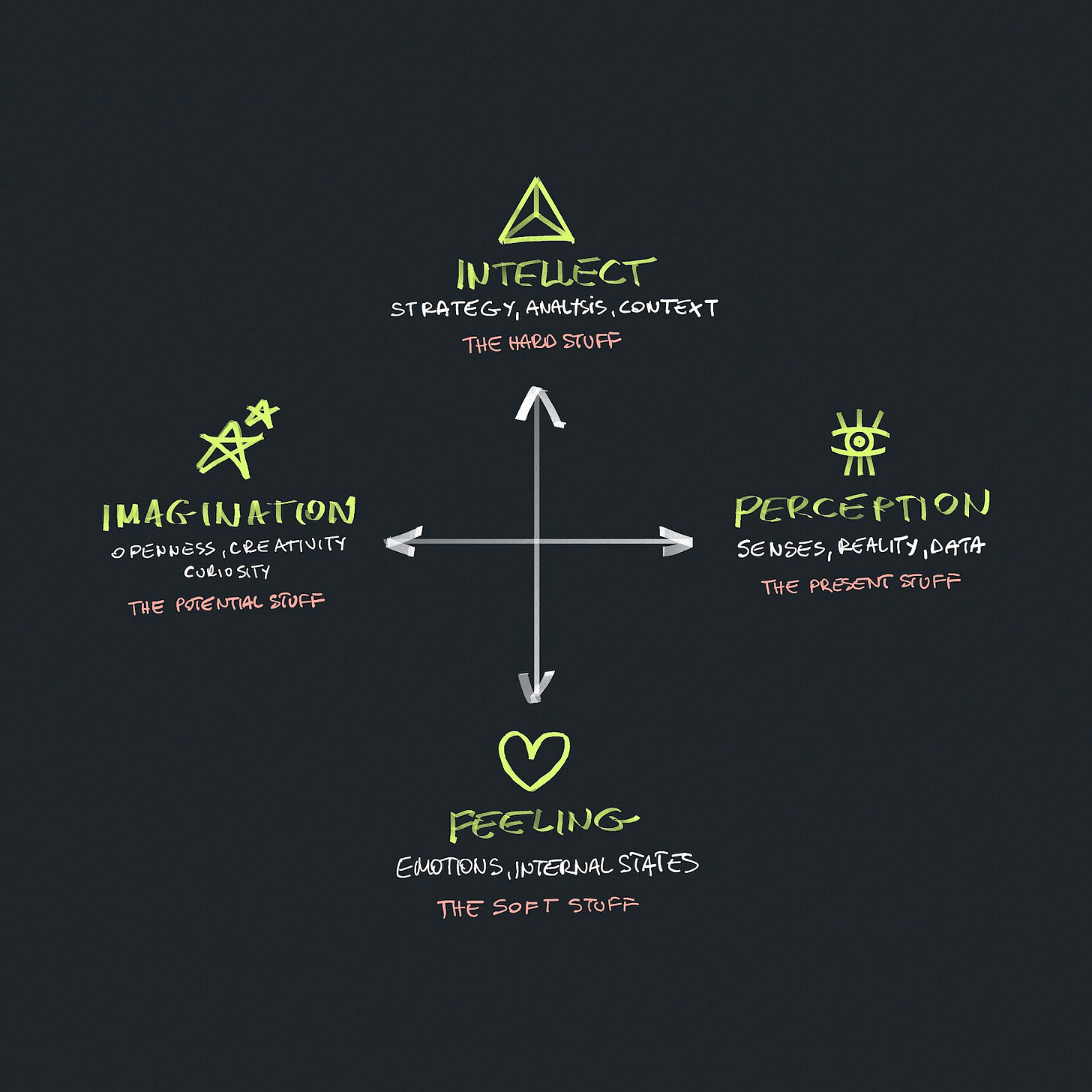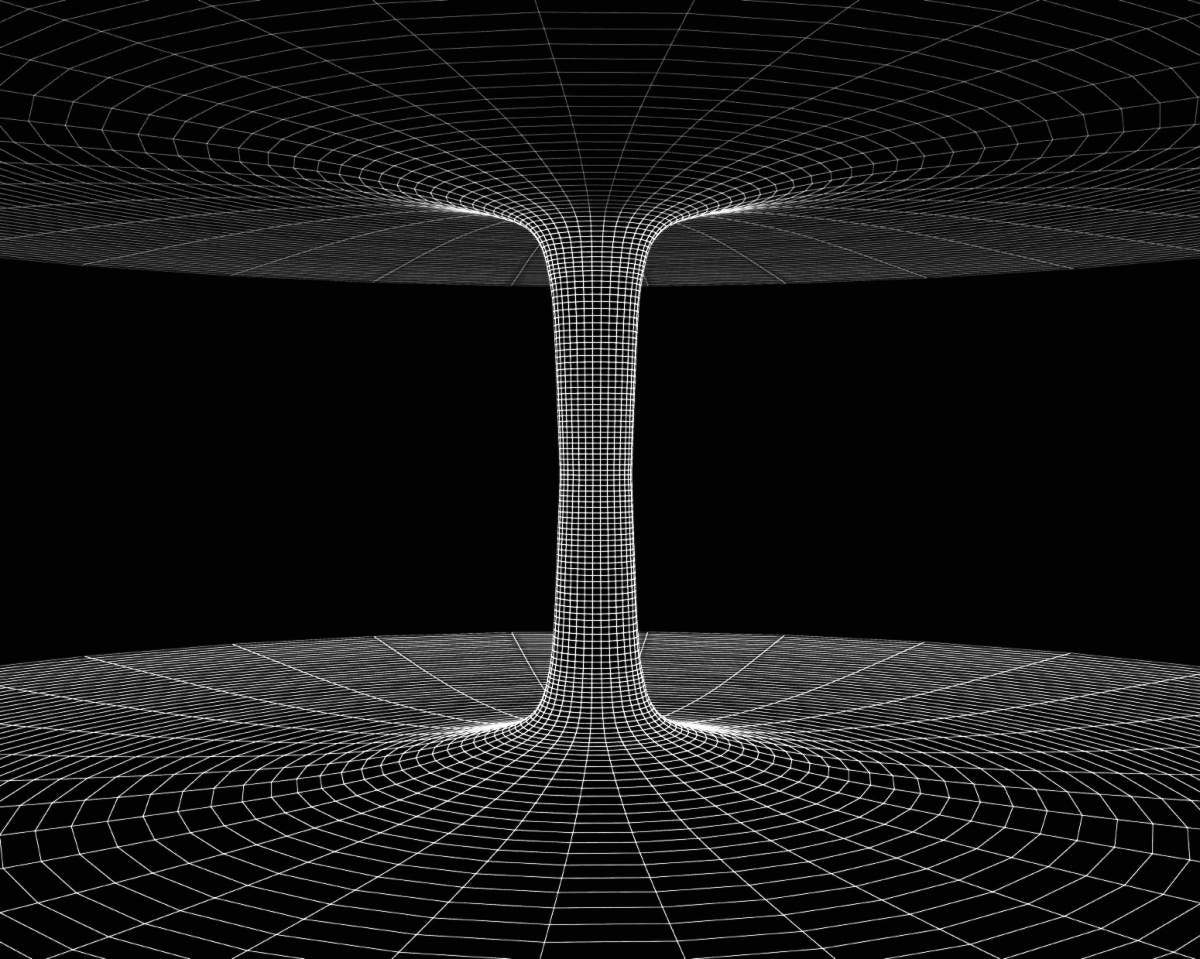Research as Exploration: A Holistic Approach
Navigating Intellect, Feeling, Imagination, and Perception
Some people scale mountains, others train dogs, but I dive deep into research. It's not just an activity for me — it's an experience: rich, flavorful, personal, surprising, and delightfully non-linear. Each research journey makes me a bit wiser (hopefully) and more whole as a person.
What I'm sharing isn't ordinary research methodology. This is personal, exploratory research — the kind you do for yourself rather than for a company, the kind that goes beyond simply answering questions. I've come to believe that good research enables you to answer questions, but great research enables you to meet with yourself. In this deeper form of exploration, answering the initial questions becomes almost a by-product of the process.
Let me invite you into the backend of my mind where research happens. There are no dragons here — just sophisticated frameworks, dimensional tunnels, and perspective-shifting wormholes. What I've discovered through years of self-taught exploration (hello, learner mindset!) is a four-dimensional approach I call ‘Holistic Research.’ This framework has transformed how I explore topics, allowing me to tap into analytical rigor while also embracing emotional resonance, creative possibility, and sensory reality.
Whether you're a researcher by profession or simply a curious mind, this approach might just change how you think about the exploration of ideas. Let's jump in! 😇 🙏
The rewards and challenges of research
I also love to ‘do’ research because I love to explore. A great exploration is a multi-modal exploration. Multi-modal meaning that you are open to and actively holding the space to receive as much new info and insights as possible. In as many forms as possible.
Curious minds would generally agree that, as we do research — we are learning about a great deal of things other than the research topic itself. This is a rich experience which I’m truly grateful to be able to do every time I sit down to do the research. And this is something unique to personal exploratory research in the sense that you can do it guilt-free
And if that isn’t deep enough for you, for many of us ‘research is me-search’ too. We learn about ourselves just as much as we learn about the topic that we study. We search for deep answers through researching the topics that interest us. For example, I think that many PhD candidates have indeed dedicated a good portion of their lives trying to crack the questions that were just as personal to them as visits to your therapists are to you.
Since we are getting a bit personal here — let me share something vulnerable. Just like all the things under the sun, research has its dark sides too. I love it so much that oftentimes, it got me into trouble. When I was working as a consultant for startups, I used to wildly enjoy the research and discovery phase of the project. I enjoyed it so much that I spent in this phase most of the available time I had for the entire project! And then needed to scramble with execution and implementation phases. That was often quite stressful. But thanks to the AAA quality of my team at Netguru, we have always managed to deliver on time!
The research process
So what's my research process? There are a couple of challenges with asking these sort of questions. The first one is — what do we mean by the research process?, and the second is how to describe this process to give it its justice?
I assume that by the research process we mean ‘how do I approach the sequence of actions that help me arrive at something internally coherent about a given topic I might not know a lot about yet’. On a side note, I love the ‘not yet’ part of that definition because it cuts to the bone of what research is to me — it’s about exploring the unknown and making it known a bit better.
The second challenge with describing the research process has to do with the observability of what actually happens inside the brain as I do it. And this is itself another deep rabbit hole so we won’t go there this time. I think it’s gonna be easiest for me to just describe what can be seen if you were observing me as I ‘do the research’. There will be visuals, don’t worry. A lot of visuals as a matter of fact.
Through experimenting with these diverse approaches to research — sometimes structured and quantitative, other times organic and qualitative — I began to recognize patterns in what made research truly transformative. The most profound insights seemed to emerge when I engaged with topics not just analytically, but through multiple modes of knowing. This realization led me to develop what I call the 'Holistic Research' framework: a matrix with four main dimensions that, when accessed together, create a complete research experience.
Intro to the process
My research process is... diverse. Plus it’s changing, and evolving constantly. Sometimes it’s organic and qualitative, other times very structured and quantitative. What’s more, the process I follow heavily depends on the piece I'm writing about and its length (longform vs shortform). In my book, longform is anything above 2300+ words, Shorform is below 1500 words. Interestingly, I’ve found out that this word-length boundary is only theoretical - because everything I write wants to become a long form with a shitton of research ;). I call it the bullshit boundary. But I digress. Again, as you can clearly see I love doing research.
Multiple perspectives
There’s one special truism circulating among researchers: To get the full richness and flavour of the thing you are researching – you need to perceive it from multiple angles. This is good advice, but it has been misunderstood by many. Me included.
You see, the problem is that most people stop the research just before it actually gets really interesting! Sure, they view the topic from multiple angles and what not, incorporating analytical, strategic or historical thinking. But what they miss out on is a huge dimension of what I call the ‘Imaginative feeling’ side of doing research.
Remember the futuristic writing concept? Well, it appears that futuristic writing enables you to tap into this mysterious dimension. And you wanna tap there — because it grants you access to truly unique and deep perspectives on the matter you research!
The Holistic Research
I have devised a framework which will help you understand how I look at research. Hell! — not only how I look at it but also how I experience it! I call it the Holistic Research. This is where it gets personal folks.
The framework is a matrix with four main dimensions. Yes, four — not one! I believe that all master holistic researchers are able to tap into all four dimensions effortlessly as they ‘do’ the research. This is the holy grail of holistic research.
Let’s get into the details shall we. The first two dimensions are Intellect and Feeling. The hard stuff and the soft stuff.
Intellect — the hard stuff
Intellect in this sense is about using the mind to think scientifically. To strategize, analyze and seize the context. It provides the structure (as all hard, grid-like things do). Structure is key for research because it binds the stuff together, and enables any stuff that is about to emerge in the process to stick together and bear shape. Without the Intellect dimension — you do your research void of context, and full of bias.
It’s hard to imagine doing research without having at least some basic questions to answer. The Intellect dimension enables these questions to be formulated. The formula should always end with a universally recognizable symbol for a question — ‘?’. This may sound trivial to you, but it isn’t so obvious once we go deeper.
Without the intellect, there’s no form. Without the form, there’s no question. Without the question, there’s no research. You get the idea.
This dimension is coincidently (or not) the place where researchers often start their process from. Think of this dimension as a tunnel, or even better — a rabbit hole. Researchers and other curious people get into this tunnel/hole because they follow ‘the itch’. Then, they carefully get inside, once they have identified the research questions.
Allright, so we went down the rabbit hole, pulled by curiosity and armed with the research questions serving as our only light source. However we will need something more than mere intellect to navigate when it gets really dark. And believe me, it will. This is where the Feeling dimension comes into play.
Feeling — the soft stuff
You don’t need sight in this dimension. But you need your heart. Because when you tap to the Feeling dimension, you focus on emotions. And you let them guide you, as you do the research. This is an incredibly powerful ability to learn as a researcher, because it extends your perspective 10-fold.
Feeling is concerned with the internal states of being. You know — the fleeting states, and the goey space. Here, things are hard to pin down, and ever-elusive. Sometimes, when you focus on this dimension, you feel like you are flowing. And you would be right — it's like tapping to a free-flowing river which flows through you. It’s flowing all the time (unless you are unconscious), no matter what you do.
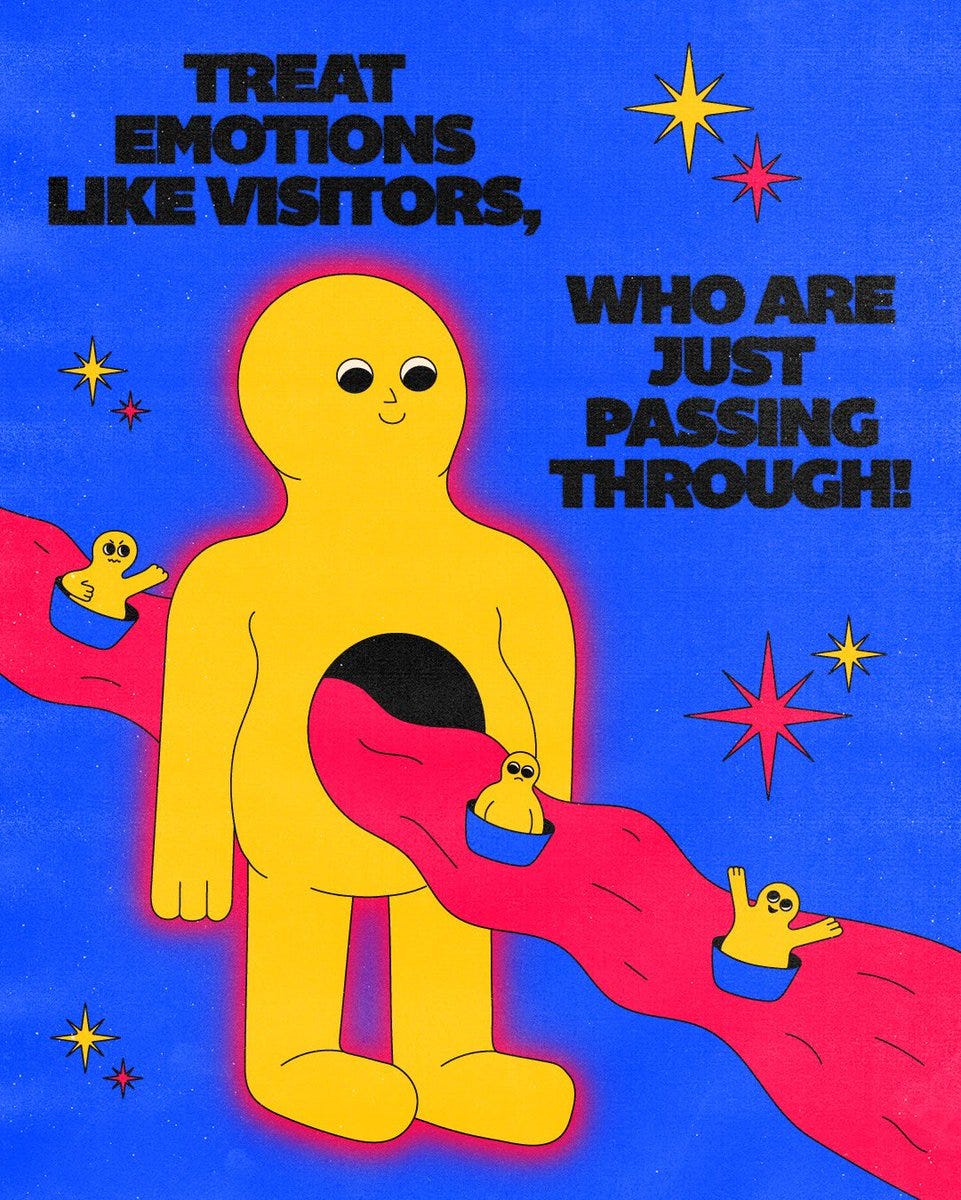
Feeling is 100% biased and subjective. And it’s a welcome thing. In that regard — it’s a far cry from the ordered and unbiased Intellect space for sure. But you need it. And it complements the Intellect beautifully.
The Feeling dimension provides the heart and the motivation to the holistic research process. Without it — the process is uninspiring and… kinda dead. Lifeless. What’s the point of doing something when you ‘feel like’ whatever about it, right?
When you engage in the reserach process, notice how certain ideas make you feel. Ask yourself — what’s your gut reaction to a particular vision or a specific concept. Does the the thing make you fell warmth, or you shiver with just a thought? Are you excited or calm when you interact with it? Consider what others could feel as well — What would inspire them?, what would make them curious, or brave? Emotions are powerful information carriers. Tapping into this information will not only enrich the overall exploration, but will also serve as basis for weaving stories you will tell others in the future.
But there’s more! Remember that there are four dimensions to the holistic research process. Let’s cover the remaining two of them. Imagination and Perception. Former being the potential stuff, and latter the present stuff.
Imagination — the potential stuff
Imagination is all about openness, creativity and curiosity. It relates to the ‘what could be’. This dimension is like the futurist wet dream of infinite possibilities. A source of deep insights, and the playground for wild ideas to emerge. Imagination should be cultivated by all researchers as it provides the necessary depth of insight. Without it, your insights will be shallow and bleak.
Imagination is super strong because it enables us to perceive, operate and experience intangible ideas or concepts as if they were existing objects. When you learn to let it run wild, it will reciprocate with breathing life into inanimate matter. Especially when you combine it with the Feeling dimension! I will share with you some powerful combinations of all four dimensions later.
Taping to imagination enables good researchers to reframe problems and connect the dots across seemingly disjointed ideas and concepts. I use imagination to fill-in the blanks between concepts, identify un-obvious relationships, or paint the picture how things could work (Intellect), look like (Perception) and feel like (Feeling) in the future. And yes, you can combo these dimensions (Imagination + Feeling) to widen your perspective. Which is the whole point of Holistic Research!
The cardinal rule of this dimension is — reserving any judgment. You need to open up for the endless possibilities that await. Wear the ‘yellow hat’, carry the light in the darkness, and light-up all wierd shapes to discover new constellations. Reserve opinions for later. The extent to which you are able to turn off the often over-developed criticism muscle is exactly proportionate to the freshness and depth of your ideas. Ignoring judgment is key to true imagination.
If the Intellect dimension is a tunnel you fly through as you research, the Imagination is all the wormholes you encounter on your way. Wormholes connect places (and ideas) that are far, far away from each other. And as a result — they enable you to move and learn quickly. There’s one caveat though. They are one way street.
Let’s now leave the wormholes and the Imagination land, and move to the other side of the spectrum. The fourth dimension is the Perception. Let’s see what it has in store for us.
Perception — the present stuff
Perception dimension is all about the senses, sensory information and maintaining contact with reality. Any master researcher is keenly aware of their 7 senses: Sight, Smell, Taste, Touch, Hear, Balance, Body awareness. These senses enable us to get in contact with reality.
Researchers access this dimension whenever they are probing, gathering and analyzing the data flows. Here the quantitative and qualitative methods reside. Together with their natural counterpart (or sister) — the intuition. The quant and qual draw from the Intellect, whereas intuition is guided by the Feeling dimension.
Perception dimension provides relevancy. Without it, the research quickly gets out of touch and unreal. It's getting miss-informed, too far-out, lacking any grounding and as the result — lacking gravitas. Keen observers will notice that this fourth dimension elegantly balances the third one (Imagination). It focuses on what’s here and now, and ignores everything else (the past or the future). It’s a snapshot of ‘what is’.
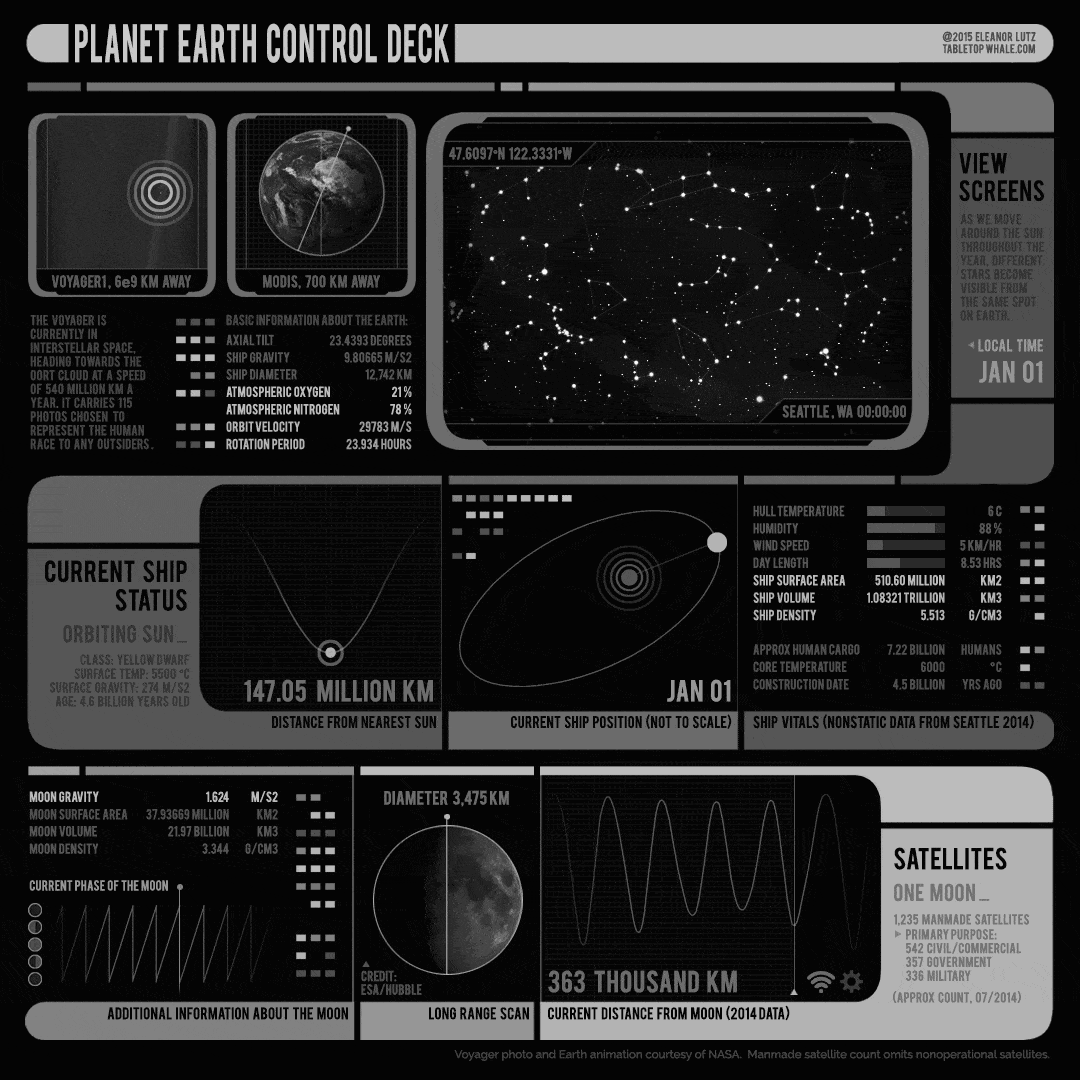
To help you visualize this dimension, imagine a pilot's cockpit — full of sensors and dials. With the use of these instruments, one can observe what is happening in real time and make decisions based on data and/or intuition.
The true power of holistic research emerges when you learn to dance between all four dimensions with fluidity and purpose. Like a skilled pilot navigating through both clear skies and storms, the holistic researcher moves deliberately between Intellect's analytical structure, Feeling's emotional resonance, Imagination's potential futures, and Perception's grounding reality. This dynamic interplay creates a research experience that's not just intellectually rigorous but personally transformative.
When you operate from the center of these four dimensions, your insights deepen, your perspective expands, and your research takes on a living quality—breathing, evolving, and revealing truths beyond the initial questions. In this centered space, the boundaries between researcher and research blur, and what emerges isn't just knowledge about a topic, but wisdom about yourself and your relationship to the world. This is the ultimate promise of holistic research: not merely to answer questions, but to transform the questioner.
What's Coming in Part 2: The Hidden Connections
While understanding the four dimensions is essential, the true magic of holistic research happens in the spaces where these dimensions meet and interact. In Part 2 of this series, I'll explore what I call the ‘Areas, Planes, and Dynamics’ of holistic research:
Areas: The intersection points where two dimensions create unique research approaches (like ‘How could the future look like?’ and ‘How could the future feel like?’)
Planes: The broader spaces of personal/public and potential/present that shape our research context
Dynamics: The flowing motion between dimensions that brings research to life
These connections transform holistic research from a static framework into a living, breathing practice. Stay tuned!
Jan 🙏






